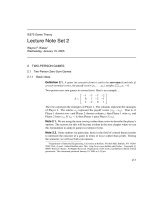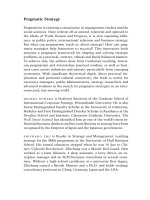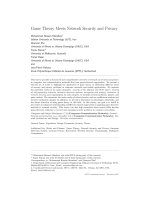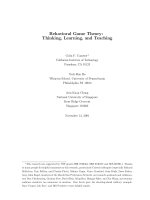Game Theory
Bạn đang xem bản rút gọn của tài liệu. Xem và tải ngay bản đầy đủ của tài liệu tại đây (3.01 MB, 23 trang )
CHAPTER
11
Game Theory
Introduction
Probability is used in what is called game theory. Game theory was developed
by John von Neumann and is a mathematical analysis of games. In many
cases, game theory uses probability. In a broad sense, game theory can be
applied to sports such as football and baseball, video games, board games,
gambling games, investment situations, and even warfare.
Two-Person Games
A simplified definition of a game is that it is a contest between two players
that consists of rules on how to play and how to determine the winner.
A game also consists of a payoff. A payoff is a reward for winning the game.
In many cases it is money, but it could be points or even just the satisfaction
of winning.
Most games consist of strategies.Astrategy is a rule that determines a
player’s move or moves in order to win the game or maximize the player’s
187
Copyright © 2005 by The McGraw-Hill Companies, Inc. Click here for terms of use.
payoff. When a game consists of the loser paying the winner, it is called a zero
sum game. This means that the sum of the payoffs is zero. For example, if a
person loses a game and that person pays the winner $5, the loser’s payoff
is À$5 and the winner’s payoff is þ$5. Hence the sum of the payoff is
À$5 þ $5 ¼ $0.
Consider a simple game in which there are only two players and each
player can make only a finite number of moves. Both players make a move
simultaneously and the outcome or payoff is determined by the pair of
moves. An example of such a game is called, ‘‘rock-paper-scissors.’’ Here
each player places one hand behind his or her back, and at a given signal,
brings his or her hand out with either a fist, symbolizing ‘‘rock,’’ two fingers
out, symbolizing ‘‘scissors,’’ or all five fingers out symbolizing ‘‘paper.’’ In
this game, scissors cut paper, so scissors win. A rock breaks scissors, so the
rock wins, and paper covers rock, so paper wins. Rock–rock, scissors–
scissors, and paper–paper are ties and neither person wins. Now suppose
there are two players, say Player A and Player B, and they decide to play for
$1. The game can be symbolized by a rectangular array of numbers called
a payoff table, where the rows represent Player A’s moves and the columns
represent Player B’s moves. If Player A wins, he gets $1 from Player B. If
Player B wins, Player A pays him $1, represented by À$1. The payoff table
for the game is
Player B’s Moves:
Player A’s Moves: Rock Paper Scissors
Paper 0 À$1 $1
Rock $1 0 À$1
Scissors À$1 $1 0
This game can also be represented by a tree diagram, as shown in
Figure 11-1.
Now consider a second game. Each player has two cards. One card is
black on one side, and the other card is white on one side. The backs of all
four cards are the same, so when a card is placed face down on a table,
the color on the opposite side cannot be seen until it is turned over. Both
players select a card and place it on the table face down; then they turn the
cards over. If the result is two black cards, Player A wins $5. If the result
is two white cards, Player A wins $1. If the results are one black card and
CHAPTER 11 Game Theory
188
one white card, Player B wins $2.00. A payoff table for the game would
look like this:
Player B’s Card:
Player A’s Card: Black White
Black $5 À$2
White À$2 $1
The tree diagram for the game is shown in Figure 11-2.
Player A thinks, ‘‘What about a strategy? I will play my black card and
hope Player B plays her black card, and I will win $5. But maybe Player B
knows this and she will play her white card, and I will lose $2. So, I better
Fig. 11-1.
Fig. 11-2.
CHAPTER 11 Game Theory
189
play my white card and hope Player B plays her white card, and I will win $1.
But she might realize this and play her black card! What should I do?’’
In this case, Player A decides that he should play his black card some of
the time and his white card some of the time. But how often should he play
his black card?
This is where probability theory can be used to solve Player A’s dilemma.
Let p ¼ the probability of playing a black card on each turn; then 1 À p ¼ the
probability of playing a white card on each turn. If Player B plays her black
card, Player A’s expected profit is $5 Á p À $2(1 À p). If Player B plays her white
card, Player A’s expected profit is À$2p þ $1(1 À p), as shown in the table.
Player B’s Card
Player A’s Card Black White
Black $5p À$2p
White À$2(1 À p) $1(1 À p)
$5p À $2(1 À p) À$2p þ $1(1 À p)
Now in order to plan a strategy so that Player B cannot outthink Player A,
the two expressions should be equal. Hence,
5p À 2ð1 À pÞ¼À2p þ 1ð1 À pÞ
Using algebra, we can solve for p:
5p À 2ð1 À pÞ¼À2p þ 1ð1 À pÞ
5p À 2 þ 2p ¼À2p þ 1 À p
7p À 2 ¼À3p þ 1
7p þ 3p À 2 ¼À3p þ 3p þ 1
10p À 2 ¼ 1
10p À 2 þ 2 ¼ 1 þ 2
10p ¼ 3
10p
10
¼
3
10
p ¼
3
10
CHAPTER 11 Game Theory
190
Hence, Player A should play his black card
3
10
of the time and his white
card
7
10
of the time. His expected gain, no matter what Player B does, when
p ¼
3
10
is
5p À 2ð1 À pÞ¼5 Á
3
10
À 21À
3
10
¼
15
10
À 2
7
10
¼
15
10
À
14
10
¼
1
10
or $0:10
On average, Player A will win $0.10 per game no matter what Player B does.
Now Player B decides she better figure her expected loss no matter what
Player A does. Using similar reasoning, the table will look like this when the
probability that Player B plays her black card is s, and her white card with
probability 1 À s.
Player B’s Card:
Player’s A Card: Black White
White $5s À$2(1 À s)$5s À $2(1 À s)
Black À$2s $1(1 À s) À$2(s) þ $1(1 À s)
Solving for s when both expressions are equal, we get:
5s À 2ð1 À sÞ¼À2ðsÞþ1ð1 À sÞ
5s À 2 þ 2s ¼À2s þ 1 À s
7s À 2 ¼À3s þ 1
7s þ 3s À 2 ¼À3s þ 3s þ 1
10s À 2 ¼ 1
10s À 2 þ 2 ¼ 1 þ 2
10s ¼ 3
10s
10
¼
3
10
s ¼
3
10
CHAPTER 11 Game Theory
191
So Player B should play her black card
3
10
of the time and her white card
7
10
of the time. Player B’s payout when s ¼
3
10
is
$5s À $2ð1 À sÞ¼5
3
10
À $2
7
10
¼
15
10
À
14
10
¼
1
10
or $0:10
Hence the maximum amount that Player B will lose on average is $0.10
per game no matter what Player A does.
When both players use their strategy, the results can be shown by
combining the two tree diagrams and calculating Player A’s expected gain
as shown in Figure 11-3.
Hence, Player A’s expected gain is
$5
9
100
À $2
21
100
À $2
21
100
þ $1
49
100
45
100
À
42
100
À
42
100
þ
49
100
¼
10
100
¼ $0:10
The number $0.10 is called the value of the game. If the value of the game
is 0, then the game is said to be fair.
Fig. 11-3.
CHAPTER 11 Game Theory
192
The optimal strategy for Player A is to play the black card
3
10
of the time
and the white card
7
10
of the time. The optimal strategy for Player B is the
same in this case.
The optimal strategy for Player A is defined as a strategy that can
guarantee him an average payoff of V(the value of the game) no matter what
strategy Player B uses. The optimal strategy for Player B is defined as a
strategy that prevents Player A from obtaining an average payoff greater
than V(the value of the game) no matter what strategy Player A uses.
Note: When a player selects one strategy some of the time and another
strategy at other times, it is called a mixed strategy, as opposed to using the
same strategy all of the time. When the same strategy is used all of the time,
it is called a pure strategy.
EXAMPLE: Two generals, A and B, decide to play a game. General A can
attack General B’s city either by land or by sea. General B can defend either
by land or sea. They agree on the following payoff.
General B (defend)
Land Sea
General A (attack) Land À$25 $75
Sea $90 À$50
Find the optimal strategy for each player and the value of the game.
SOLUTION:
Let p ¼ probability of attacking by land and 1 À p ¼ the probability of attack-
ing by sea.
CHAPTER 11 Game Theory
193
General A’s expected payoff if he attacks and General B defends by land is
À$25p þ $90(1 À p) and if General B defends by sea is $75p À $50(1 À p).
Equating the two and solving for p, we get
À25p þ 90ð1 À pÞ¼75p À 50ð1 À pÞ
À25p þ 90 À 90p ¼ 75p À 50 þ 50p
À115p þ 90 ¼ 125p À 50
À115p À 125p þ 90 ¼ 125p À 125p À 50
À240p þ 90 ¼À50
À240p þ 90 À 90 ¼À50 À 90
À240p ¼À140
À240p
À240
¼
À140
À240
p ¼
7
12
Hence General A should attack by land
7
12
of the time and by sea
5
12
of the
time. The value of the game is
À 25p þ 90ð1 À pÞ
¼À25
7
12
þ 90
5
12
¼ $22:92
Now let us figure out General B’s strategy.
General B should defend by land with a probability of s and by sea with a
probability of 1 À s. Hence,
CHAPTER 11 Game Theory
194
À25s þ 75ð1 À sÞ¼90s À 50ð1 À sÞ
À25s þ 75 À 75s ¼ 90s À 50 þ 50s
À100s þ 75 ¼ 140s À 50
À100s À 140s þ 75 ¼ 140s À 140s À 50
À240s þ 75 ¼À50
À240s þ 75 À 75 ¼À50 À 75
À240s ¼À125
À240s
À240
¼
À125
À240
s ¼
25
48
Hence, General B should defend by land with a probability of
25
48
and by
sea with a probability of
23
48
. A tree diagram for this problem is shown
in Figure 11-4.
A payoff table can also consist of probabilities. This type of problem is
shown in the next example.
Fig. 11-4.
CHAPTER 11 Game Theory
195









